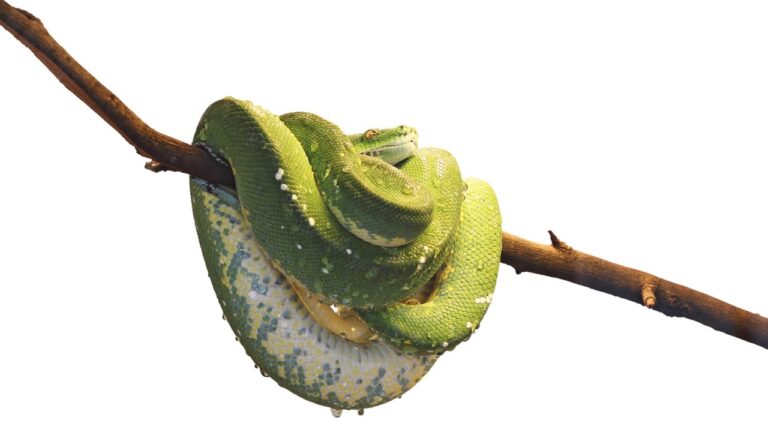Understanding Snake Scale Rot: Common Health Condition in Snakes
Brief overview of snake scale rot
Snake Scale Rot is a common health condition that affects snakes, comparable in severity to conditions such as snake mouth rot and snake mites. This ailment, often a consequence of poor living conditions, is characterized by the deterioration of the snake’s scales, leading to visible discoloration and potential harm to the snake’s overall health.
Scale rot, also known as necrotic dermatitis, can be a daunting challenge for both novice and experienced snake owners alike. It’s a form of skin infection that, if left unchecked, can result in serious complications. The condition is typically caused by bacterial or fungal infections, which invade the snake’s scales, causing them to become discolored, inflamed, and potentially leading to further health problems.
In the following sections, we will dive deeper into the specifics of snake scale rot, its causes, types, prevention methods, and treatments. Additionally, we will explore the impact of this condition on the snake’s physical health and behavior, emphasizing the importance of early detection and treatment. With the right knowledge and understanding, snake scale rot can be prevented or effectively treated, ensuring the long-term health and well-being of your reptilian companion.
What is Snake Scale Rot
Definition and Explanation
Snake Scale Rot, also known as Necrotic Dermatitis, is a common medical condition that afflicts snakes. It is characterized by discoloration, blistering and, in severe cases, necrosis (death) of the snake’s scales.
This condition is not a disease in itself, but rather a symptom of an underlying problem, typically a bacterial or fungal infection. It’s crucial to note that while it can be serious if left untreated, scale rot is generally preventable and treatable with proper care and attention.
Causes and Symptoms
Snake Scale Rot primarily occurs due to unsanitary and humid conditions in the snake’s habitat. Bacteria or fungi thrive in such environments and can infest the snake’s scales, leading to rot. In addition to this, improper shedding, injuries, or abrasion can open up the snake’s skin to infections, potentially leading to scale rot.
The symptoms of scale rot can vary depending on the severity and cause of the condition. However, some common signs to look out for include:
- Discoloration: Scales may become unusually dark or bright. This is often the first noticeable sign of scale rot.
- Blistering: Affected scales may develop blisters filled with fluid.
- Redness or inflammation: The skin beneath the scales may appear red and swollen.
- Necrosis: In severe cases, the scales may die and begin to fall off, exposing raw skin underneath.
Additional secondary symptoms can include lethargy, loss of appetite, or changes in behavior, which may point to a systemic infection such as snake septicemia or snake respiratory infection.
In conclusion, early detection and prompt action can prevent the progression of snake scale rot. Regularly inspect your snake for signs of scale rot and maintain a clean, well-regulated habitat to ensure the health and longevity of your reptilian companion.
Different Types of Scale Rot
When it comes to snake scale rot, two primary types can impact the health of your slithering friend: bacterial scale rot and fungal scale rot. Both of these conditions are relatively common in captive snakes and, if left untreated, can lead to severe health complications.
Bacterial Scale Rot
Bacterial scale rot, also known as septicemic cutaneous ulcerative disease (SCUD), is a bacterial infection that often affects the outer layer of a snake’s skin. This type of scale rot is typically caused by a bacterial invasion in the snake’s scales, which can result from improper habitat conditions, injury, or an untreated wound.
Symptoms of bacterial scale rot include redness, swelling, and the presence of pus-filled blisters or ulcers on the snake’s skin. The scales may also appear discolored, often taking on a dark or black hue. It’s crucial to recognize these signs early, as bacterial scale rot can lead to more serious conditions like snake septicemia if not addressed promptly.
Fungal Scale Rot
On the other hand, fungal scale rot is a fungal infection that manifests in the form of white, yellow, or gray patches on the snake’s scales. This condition is most commonly caused by the fungus Trichosporon cutaneum, though other fungi can also be responsible. Similar to bacterial scale rot, fungal scale rot can stem from subpar habitat conditions or injuries.
The symptoms of fungal scale rot are somewhat similar to those of its bacterial counterpart, including discolored patches and potential ulceration. However, unique to fungal scale rot is a powdery or cotton-like appearance on the affected scales. Without proper treatment, this condition can lead to snake infectious stomatitis, also known as snake mouth rot.
Understanding the differences between bacterial and fungal scale rot, their causes, and symptoms is vital in maintaining the health of your snake. Early detection and treatment can prevent these conditions from leading to more severe health problems, ensuring your slithery companion remains healthy and active for years to come.
How to Prevent Snake Scale Rot
Prevention is the cornerstone of maintaining the health of your slithery companion, and this adage holds particularly true when it comes to snake scale rot. By focusing on creating the proper habitat conditions, implementing regular cleaning protocol, and ensuring proper feeding and handling, you can keep this common condition at bay.
Proper Habitat Conditions
The environment in which a snake lives plays a pivotal role in its overall health. A well-regulated, clean, and appropriate habitat can help prevent the onset of scale rot. In particular, pay close attention to temperature and humidity levels. Each snake species has its own ideal climate, and deviating from this can lead to stress and subsequent health issues like scale rot, or even snake mouth rot.
Ensure your snake’s enclosure mimics its natural habitat as closely as possible, with appropriate places for hiding, basking, and climbing. Be vigilant about preventing damp or overly moist conditions that can encourage bacterial or fungal growth, which can lead to different types of scale rot.
Regular Cleaning
A hygienic living environment is a prerequisite for a healthy snake. Regular cleaning of the enclosure, including the removal of uneaten food, feces, and shed skin, can significantly reduce the risk of scale rot.
Implement a routine cleaning schedule to disinfect the enclosure and all of its contents. This will prevent the accumulation of harmful bacteria or fungi. Additionally, be mindful of snake mites, as these pests can also contribute to scale rot.
Proper Feeding and Handling
The diet and handling of a snake can indirectly influence the risk of scale rot. A well-fed snake is generally healthier and more resistant to diseases. Ensure your snake is receiving a balanced diet suitable for its species and size. Overfeeding or underfeeding can lead to stress, making your snake more susceptible to infections such as scale rot or snake septicemia.
When handling your snake, cleanliness is key. Always wash your hands before and after touching it to prevent the spread of any potential pathogens.
In conclusion, preventing snake scale rot is a comprehensive process that requires attention to habitat conditions, cleanliness, and proper care. Stay tuned to your snake’s behavior and physical condition, as early detection is paramount in treating any potential health issues. Remember, a healthy snake is a happy snake!
Treatment for Scale Rot
At-home treatments
The initial steps to treat snake scale rot can often be carried out within the comfortable confines of home, provided that the condition hasn’t progressed too severely. One of the first methods of at-home treatment involves gently cleaning the affected areas with a mild antiseptic solution. This process can help to reduce the presence of harmful bacteria, thus creating an environment conducive for healing.
A snake’s environment plays a crucial role in its overall health and the prevention of conditions like scale rot. As such, it’s essential to ensure that their habitat is properly sanitized and free from any potential irritants. Keeping the snake’s enclosure dry and clean can aid in accelerating the recovery process and help prevent the recurrence of scale rot in the future.
Moreover, it’s crucial to keep a keen eye on your snake’s diet and hydration during this phase. Ensuring that your snake is adequately hydrated and well-fed can significantly boost its immune system, thus facilitating a faster recovery.
When to consult a vet
Nevertheless, while at-home treatments can be effective in managing mild cases of scale rot, it is important to understand when professional help should be sought. If the snake’s condition does not improve, or if it worsens despite your efforts, it’s time to consult a reptile veterinarian.
A vet can accurately diagnose the type of scale rot – be it bacterial or fungal – using advanced diagnostic techniques, and prescribe appropriate medications. If left untreated or if improperly managed, scale rot can lead to serious complications like snake septicemia or even snake neurological disorders.
Moreover, a professional can guide you on how to adjust your snake’s living conditions and care routines to prevent future outbreaks. They can also enlighten you about other common snake health issues such as snake mouth rot, snake mites treatment or snake shedding problems, thereby equipping you with the knowledge to provide the best care for your snake.
Remember, early detection and immediate professional intervention can make all the difference in the health and longevity of your pet snake.
Impact of Scale Rot on Snakes
Physical Impact
The physical impact of scale rot on a snake is both noticeable and significant. The scales, usually smooth and uniform, become discolored, often developing a reddish or brownish hue. This discoloration is an immediate indication of the damage occurring beneath the surface. As the condition progresses, the scales may begin to lift, producing a rough, uneven texture.
In severe cases, the scales may even fall off, exposing the raw, sensitive skin beneath. This leads to an increased risk of secondary infections, such as snake septicemia or snake mouth rot, making the snake more susceptible to further health problems.
Moreover, if left untreated, scale rot can lead to systemic infections, potentially causing damage to vital organs such as the kidneys. In such cases, the snake may also develop snake kidney disease, further deteriorating its health.
Behavioral Impact
Aside from the physical implications, scale rot can significantly alter a snake’s behavior. The discomfort and stress caused by the condition can lead to changes in eating habits, with the snake refusing food or eating less than usual. This loss of appetite can lead to weight loss and weakened immunity, leaving the snake more vulnerable to other diseases.
Furthermore, snakes suffering from scale rot often become lethargic and show reduced activity levels. They may also become more aggressive due to the discomfort and stress related to the condition. If you notice such behavioral changes, they may be indicative of a health issue like scale rot, and you should seek immediate veterinary assistance.
In conclusion, the impact of scale rot is profound, affecting both the physical health and behavior of a snake. Early detection and treatment are vital to prevent the condition from escalating and causing further harm. Apart from scale rot, various other health issues like snake respiratory infection and snake shedding problems can affect snakes, emphasizing the importance of regular health checks and proper care.
Conclusion
Importance of Early Detection and Treatment
In the world of snake health, early detection and treatment are vital. Just as with any health concern, the sooner scale rot is identified, the better the chances of a successful recovery. This is particularly true for scale rot, as it’s a condition that can rapidly deteriorate if left untreated.
Moreover, early intervention can significantly reduce the risk of other severe health complications, such as snake septicemia and snake neurological disorders, which can arise from untreated scale rot. Therefore, it is imperative for snake owners to regularly inspect their pet for any signs of scale rot and to take immediate action if any are discovered.
Final Thoughts on Maintaining Snake Health
Maintaining the health of your snake is not a responsibility to be taken lightly. A snake’s wellbeing is a delicate balance that requires constant vigilance and care. Proper habitat conditions, regular cleaning, and appropriate feeding and handling are all crucial components of this balance.
Furthermore, owners should not hesitate to seek professional help when needed. If you’re uncertain about the health of your snake or if it shows symptoms of scale rot or any other serious condition, consulting a vet should always be your first course of action.
In the end, it’s about understanding and respecting the needs of your snake. This means educating yourself about potential health issues like scale rot and taking preventative measures to keep such problems at bay. After all, the prize for your efforts is a healthy, happy snake, and there’s no greater reward for a snake owner.
Remember, it’s not just about treating scale rot, but also about preventing it in the first place. And if prevention fails, swift, decisive action can make all the difference in the world to your snake’s health.







